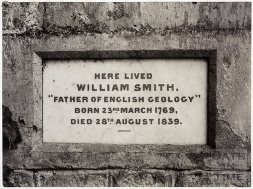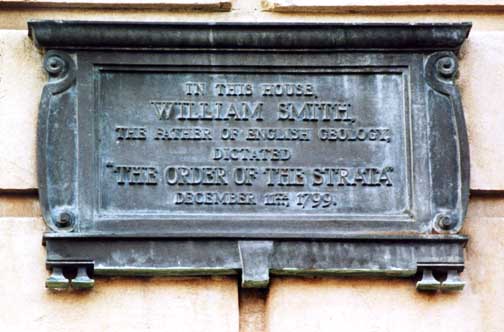Geologist and Science writer Nina Morgan attempts to right some wrongs
 On 22 March 2015 – the 246th anniversary of Smith's birth – a plaque was unveiled at the site of his birthplace in the village of Churchill, near Chipping Norton in Oxfordshire. The following day, another plaque was dedicated at 15 Buckingham Street, London, the site of the house that served as his base between 1804-1819. These new additions bring the total number of Smith monuments and plaques in the UK up to eight – and it turns out, serve to set the record straight. Each of the earlier six monuments contains errors.
On 22 March 2015 – the 246th anniversary of Smith's birth – a plaque was unveiled at the site of his birthplace in the village of Churchill, near Chipping Norton in Oxfordshire. The following day, another plaque was dedicated at 15 Buckingham Street, London, the site of the house that served as his base between 1804-1819. These new additions bring the total number of Smith monuments and plaques in the UK up to eight – and it turns out, serve to set the record straight. Each of the earlier six monuments contains errors.
A signpost memorial erected in at Rugborne Farm High Littleton Somerset, where Smith lodged 'for half a guinea a week, plus half a crown for his horse' while surveying the local coal mines states that Smith lived there from 1792-1795. He actually took up residence in October, 1791.
The plaque at Tucking Mill, near Midford outside of Bath (picture, right), which was designed to mark the house Smith purchased in 1798, is placed on the nearby and charmingly-styled Tucking Mill Cottage, rather than on the ashlar-faced and more austere Tucking Mill House, one side of which Smith actually owned. (Debates continue as to which side that was!)
 A Bronze plaque at 29 Pulteney Street, Bath, the former residence of the Reverend Joseph Townsend [1739-1816, left], states that William Smith first dictated his list of the strata around Bath to Townsend and the Reverend Benjamin Richardson on December 11 1799. But the event actually took place 6 months earlier, on June 11, 1799.
A Bronze plaque at 29 Pulteney Street, Bath, the former residence of the Reverend Joseph Townsend [1739-1816, left], states that William Smith first dictated his list of the strata around Bath to Townsend and the Reverend Benjamin Richardson on December 11 1799. But the event actually took place 6 months earlier, on June 11, 1799.
A plaque unveiled in 2009 on The Manor House, The Square, Stow on the Wold, Gloucestershire, marks the house where William Smith lived with his employer, the surveyor, Edward Webb, from 1787-1791. But it wrongly refers to Smith's pioneering map as a map of Britain, rather a map of England and Wales.
The monolith of local stone erected in Churchill in 1831 by the 3rd Earl of Ducie (picture, below) wrongly refers to Smith as the Father of British (rather than English) Geology.
A blue plaque hung on a building at 1 Newborough, Bar Street Elevation in Scarborough, where Smith lived from 1835 until his death in 1839, is placed on the wrong building.
 The details on the plaques may suffer from some inaccuracies – as indeed, may my own account of the errors. But one thing is certain. Right up to the end of his life Smith continued to believe that his work and discoveries were not fully appreciated. As late as June 1838, just 14 months before he died – Smith was drafting an Appeal for Support entitled "The case of the Founder of Geology." So when it comes to the plaques and monuments, accurate or not, Smith would certainly have been delighted with the recognition!
The details on the plaques may suffer from some inaccuracies – as indeed, may my own account of the errors. But one thing is certain. Right up to the end of his life Smith continued to believe that his work and discoveries were not fully appreciated. As late as June 1838, just 14 months before he died – Smith was drafting an Appeal for Support entitled "The case of the Founder of Geology." So when it comes to the plaques and monuments, accurate or not, Smith would certainly have been delighted with the recognition!
Acknowledgements
This vignette was inspired by a speech given by Hugh Torrens as he unveiled the new William Smith plaque on the site of Smith's former home in Churchill, Oxfordshire. Hugh also provided information about the earlier plaques and monuments mentioned – but any mistakes in the descriptions of the errors are mine alone! Other sources of information include: The Case of the Founder of Geology, part of a manuscript written by Smith in 1838 house in the Smith collection at the Hope Library at the Oxford University Museum of Natural History; the websites: http://bath-heritage.co.uk/smith_william.html; http://openplaques.org/plaques/1672; http://www.alamy.com/stock-photo-wiiliam-smith-plaque-stow-on-the-wold-gloucestershire-uk-60366885.html; http://commons.wikimedia.org/wiki/File:Tucking_Mill_Cottage,_Midford_-_plaque_-_geograph.org.uk_-_422748.jpg ; Cox, L.R, 1951, A signpost memorial to William Smith by L.R. Cox, Geol. Mag, 88/6, p. 441; Eyles, Joan M, 1969, William Smith (1769-1839) A Chronology of Significant Dates in His Life, Proc. Geol. Soc. London, 1657, pp. 173-176.
* Nina Morgan is a geologist and science writer based near Oxford, currently working on a book about the Geology of Gravestones.